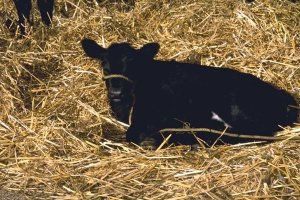
The popularity of the Angus breed belies its humble beginnings. Angus cattle originally descended from polled (naturally hornless) native cattle of Aberdeenshire and Angus, counties in northern Scotland. The strains from the two counties were crossed and recrossed over time until a distinct breed, then called the Aberdeen-Angus, was formed.
Credit for creating the Angus breed as we know it today typically goes to Hugh Watson. He systematically improved his small herd of polled cattle from the county of Angus throughout the early 1800s. The pedigrees of most purebred Angus cattle today trace back to two of his animals: a bull named Old Jock and a prolific cow named Old Granny.
The Angus breed did not arrive in America until 1873, when four bulls set foot in Sir George Grant’s new colony of Victoria. Grant believed that the breed would prove to be the ideal beef animal for the region. But when he took his bulls to the 1873 Kansas City Livestock Exposition in Missouri, the cattlemen, used to seeing only Shorthorns and Texas Longhorns, scoffed. “Freaks,” they commonly called the strange-looking black creatures without horns.
Grant did not give up. He began crossbreeding his bulls with Texas Longhorns in an effort to prove their worth. Like their Angus fathers, the resulting calves were black and hornless, but they were extremely tough, survived the winter with ease, and gained weight well in the spring. The scoffing ceased. By the time Grant died in 1878, he had firmly established the Angus breed in America. Over the next five years, 1,200 cattle arrived in the country, most of them landing in the Midwest and forming the backbone of the beef industry.

Both black and red cattle were originally accepted for registration as purebred Angus until 1917. In that year, the American Aberdeen Angus Association selected the more fashionable black as the color of choice and stopped registering reds. Some dedicated breeders, however, believed that the reds had all the advantages of the blacks, plus extra heat tolerance. Accordingly, they formed the Red Angus Association of America in 1954.
There is also a smaller version known as the American Aberdeen. Originally called the Lowline Angus, this breed was developed in Australia in 1974 by selecting smaller animals from within the Angus breed. The project was initially an experiment to see what effect high and low growth rates had on herd profitability. The Lowline produced quality beef remarkably efficiently. The herd was dispersed in two auctions in 1992 and 1993 after the experiment ended. Lowline Angus first arrived in America in 1996 and quickly earned a valuable place in the grassfed industry.
The Angus is now America’s top beef breed. A Certified Angus Beef program and a strong presence in the fast-food industry have made Angus the choice of many in the cattle business.
Uses
The Angus is a popular beef breed in its own right. However, it is also widely used in crossbreeding programs to impart desirable characteristics to the offspring:
- Hornlessness.
- Calving ease.
- Carcass quality.
- That black color that brings dollars at the sale barn.
Angus bulls are also a favorite choice for mating with dairy cattle to produce beef calves.
Temperament

Temperament varies widely throughout the breed. In general, Angus cattle have a reputation for being calm and good-natured, though perhaps not as much so as Herefords. The Angus is a very popular breed, however, and popularity tends to attract incautious and sometimes unscrupulous breeders. Therefore, some bloodlines have produced cattle that are unstable in temperament. On some parts of the continent, Angus cattle (bulls, cows, and steers alike) have even earned the reputation for being wildly aggressive.
On the whole, Lowline Angus are quiet, docile animals that should pose no temperament-related problems to new farmers and ranchers.
Health
Angus cattle are often touted as being extremely healthy and highly unlikely to get pinkeye, sunburn, or cancer because of their pigmented skin. While this is typically (though not inevitably) the case, several genetic defects lurk in the breed’s heredity:
- Dwarfism.
- Extra legs.
- Excessive bone formation.
- Neuropathic hydrocephalus, a condition in which the cranial cavity is filled with fluid.
These defects are probably due to the breed’s extreme popularity, as already explained. Also be aware that the tendency to breed bigger, harder-keeping Angus cattle has resulted in an increased susceptibility to pinkeye due to nutritional deficiencies, despite their black pigment.
Note that Lowline Angus are normal, healthy Angus cattle in a smaller package. They do not carry recessive genes for dwarfism.
Pros

- Availability.
- Toughness.
- Adaptability.
- Ability to rustle a living off of the land (especially Lowline).
- Minimal pasture damage with Lowline Angus due to lower weight.
- Longevity.
- Fertility.
- Generally good calving ease, although this has declined somewhat in larger bloodlines.
- Vigorous calves.
- Mothering ability.
- Public perception of quality.
- Speedy finishing of Lowline Angus.
- Premium prices for black hides at sale barns.
Cons
- Extreme variability in many characteristics, including health, size, temperament, feed efficiency, and calving ease.
- Possible tendency to be harder on fences than more easygoing breeds (not a problem in Lowline Angus).
- Dislike of heat (not a problem in Red Angus).
- Beef too heavily marbled for those who prefer lean meat.
- Bland flavor of the beef.
Helpful Resource
Choosing a Breed of Cattle
Is the Angus right for you? This book will help you assess your five needs and make that decision. Includes a brief profile of the Angus breed. Free sample pages are available here.



